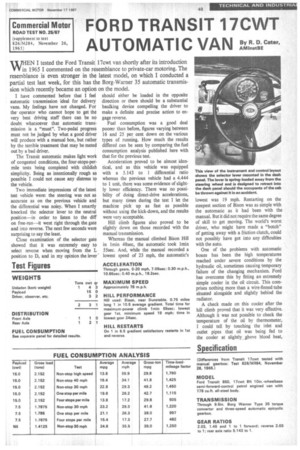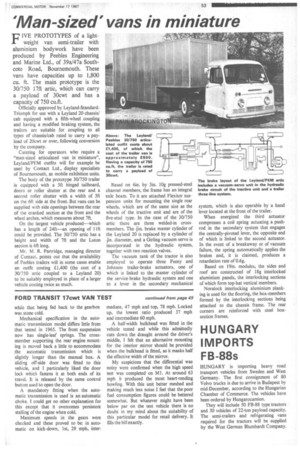FORD TRANSIT 17CWT AUTOMATIC VAN uluecater.
Page 51

Page 55

If you've noticed an error in this article please click here to report it so we can fix it.
WIEN I tested the Ford Transit 17cwt van shortly after its introduction in 1965 I commented on the resemblance to private-car motoring. The resemblance is even stronger in the latest model, on which I conducted a partial test last week, for this has the Borg-Warner 35 sion which recently became an option on the model.
automatic transmis
I have commented before that I feel automatic transmission ideal for delivery vans. My feelings have not changed. For the operator who cannot hope to get the very best driving staff there can be no doubt whatsoever that automatic transmission is a "must". Two-pedal progress must not be judged by what a good driver will produce with a manual box, but rather by the terrible treatment that may be meted out by a bad driver.
The Transit automatic makes light work of congested conditions, the four-stops-permile tests being completed with childish simplicity. Being as intentionally rough as possible I could not cause any distress to the vehicle.
Two immediate impressions of the latest test vehicle were: the steering was not as accurate as on the previous vehicle and the differential was noisy. When I smartly knocked the selector lever to the neutral position-in order to listen to the diff on free-run-it went right through the gate and into reverse. The next few seconds were surprising to say the least.
Close examination of the selector gate showed that it was extremely easy to select reverse when moving from the L position to D, and in my opinion the lever should either be loaded in the opposite direction or there should be a substantial baulking device compelling the driver to make a definite and precise action to engage reverse.
Fuel consumption was a good deal poorer than before, figures varying between 16 and 25 per cent down on the various types of running. How much the results differed can be seen by comparing the fuel consumption analysis published here with that for the previous test.
Acceleration proved to be almost identical, and as this vehicle was equipped with a 5.143 to 1 differential ratio whereas the previous vehicle had a 4.444 to 1 unit, there was some evidence of slightly lower efficiency. There was no possibility of doing direct-drive accelerations, but many times during the test I let the machine pick up as fast as possible without using the kick-down, and the results were very acceptable.
Hill climb figures also proved to be slightly down on those recorded with the manual transmission.
Whereas the manual climbed Bison Hill in lmin 48sec, the automatic took lmin 55sec. And, while the manual recorded a lowest speed of 23 mph, the automatic's
lowest was 19 mph. Restarting on the steepest section of Bison was as simple with the automatic as it had been with the manual. But it did not require the same degree of skill to get moving. The world's worst driver, who might have made a "botch" of getting away with a friction clutch, could not possibly have got into any difficulties with the auto.
One of the problems with automatic boxes has been the high temperatures reached under severe conditions by the hydraulic oil, sometimes causing temporary failure of the changing mechanism. Ford has overcome this by fitting an extremely simple cooler in the oil circuit. This comprises nothing more than a wire-finned tube situated alongside and slightly behind the radiator.
A check made on this cooler after the hill climb proved that it was very effective. Although it was not possible to check the temperature of the oil by thermometer, I could tell by touching the inlet and outlet pipes that oil was being fed to the cooler at slightly ...above blood heat,
while that being fed back to the gearbox was stone cold.
Mechanical specification in the automatic transmission model differs little from that tested in 1965. The front suspension now has single-leaf springs. The crossmember supporting the rear engine mounting is moved back a little to accommodate the automatic transmission which is slightly longer than the manual box. A sliding off-side door was fitted to this vehicle, and I particularly liked the door lock which fastens it at both ends of its travel. It is released by the same control button used to open the door.
A mandatory fitting when the automatic transmission is used is an automatic choke. I could get no other explanation for this except that it overcomes persistent stalling of the engine when cold.
Maximum speeds in the gears were checked and these proved to be: in automatic on kick-down, 1st, 29 mph, inter mediate, 47 mph and top, 78 mph. Locked up, the lowest ratio produced 37 mph and intermediate 60 mph.
A half-width bulkhead was fitted in the vehicle tested and while this admittedly cuts down the draught around the driver's middle, I felt that an alternative mounting for the interior mirror should be provided when the bulkhead is fitted, as it masks half the effective width of the mirror.
My suspicions that the differential was noisy were confirmed when the high speed test was completed on Ml. At around 63 mph it produced the most heart-rending howling. With this unit better meshed and making much less noise I feel that the poor fuel consumption figures could be bettered somewhat. But whatever might have been below par on the test vehicle there is no doubt in my mind about the suitability of this particular model for retail delivery. It fills the bill exactly.
















































































































































